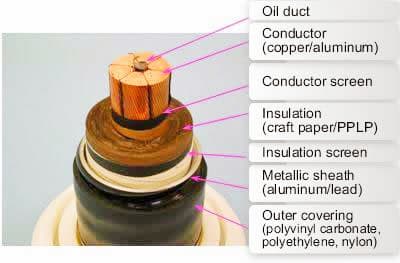
Inden for højspændingstransmission, oliefyldte kabler er dukket op som afgørende komponenter, giver unikke fordele med hensyn til effektivitet, pålidelighed, og sikkerhed. Disse kabler er designet til at modstå høj elektrisk belastning, samtidig med at de bevarer driftsintegriteten over lange afstande. Denne artikel udforsker teknologien bag oliefyldte kabler, deres ansøgninger, fordele, og fremtidsudsigter i energisektoren.
Hvad er oliefyldte kabler?
Oliefyldte kabler, også kendt som olieimprægneret papir (OIP) kabler, er en type højspændingsstrømkabel, hvor lederen er omgivet af olieimprægneret papirisolering. Olien tjener flere kritiske formål i kabelstrukturen:
- Isolering: Oliens primære funktion er at isolere lederen fra det omgivende miljø og andre ledende elementer. Olie har fremragende dielektriske egenskaber, hvilket betyder, at den kan modstå høje elektriske felter uden nedbrud.
- Køling: Olie fungerer som kølemiddel, bortledning af den varme, der genereres under drift. Denne funktion er særlig vigtig i højspændingsapplikationer, hvor varmeopbygning kan forringe kablets ydeevne.
- Mekanisk support: Det olieimprægnerede papir giver mekanisk støtte til lederen, forhindrer deformation og opretholder kablets strukturelle integritet.
Anvendelser af 132kV oliefyldt kabel
Oliefyldte kabler bruges overvejende i højspændingstransmissions- og distributionsnetværk, hvor pålidelighed og effektivitet er altafgørende. Nogle specifikke applikationer omfatter:
- 132kV transmissionsledninger: Oliefyldte kabler anvendes i vid udstrækning i 132kV og højere spændingsledninger på grund af deres evne til effektivt at transportere store mængder elektrisk strøm over lange afstande.
- Undersøiske kabler: I undervands- eller ubådsapplikationer, oliefyldte kabler foretrækkes, fordi olieisoleringen giver yderligere beskyttelse mod vandindtrængning og korrosion.
- Højspændings jævnstrøm (HVDC) Systemer: HVDC-systemer kræver kabler, der kan håndtere høje spændinger og strømme med minimale tab. Oliefyldte kabler opfylder disse krav og bruges i forbindelsesled mellem elnet og i langdistancetransmission.
Fordele ved oliefyldt kabel
- Høj isoleringsstyrke: Olie har overlegne dielektriske egenskaber sammenlignet med luft eller faste isoleringsmaterialer, tillader oliefyldte kabler at modstå høje elektriske stressniveauer uden nedbrud.
- Fremragende køleegenskaber: Olien afleder varme effektivt, forhindrer hotspots og sikrer, at kablet fungerer inden for sikre temperaturgrænser.
- Lang driftstid: Korrekt udformede og vedligeholdte oliefyldte kabler kan have en levetid på flere årtier, hvilket gør dem til et pålideligt valg til langsigtet krafttransmissionsinfrastruktur.
- Modstandsdygtighed over for miljømæssige faktorer: Olieisoleringen beskytter kablet mod fugt, forurenende stoffer, og andre miljøfaktorer, at udvide dens driftssikkerhed.
- Reduceret kapacitans: Oliefyldte kabler har typisk lavere kapacitans sammenlignet med andre typer kabler, hvilket reducerer ladestrømmene og forbedrer den samlede effektivitet.
Oliefyldte elektriske kabel udfordringer og overvejelser
Mens oliefyldte kabler giver betydelige fordele, de kommer også med nogle udfordringer:
- Opretholdelse: Regelmæssig vedligeholdelse, herunder olieprøvetagning og -test, er afgørende for at overvåge isoleringens tilstand og sikre fortsat pålidelighed.
- Miljøpåvirkning: Brugen af olie giver anledning til miljøproblemer, især i tilfælde af lækager eller spild. Moderne designs bruger miljøvenlige isolerende olier til at afbøde disse risici.
- Koste: Indledende installationsomkostninger for oliefyldte kabler kan være højere end alternativer på grund af kompleksiteten af fremstilling og installation.
Oliefyldt højspændingskabel
Fremskridt inden for materialevidenskab og fremstillingsteknikker fortsætter med at forbedre ydeevnen og effektiviteten af oliefyldte kabler. Fremtidige tendenser inkluderer:
- Nanoteknologi: Inkorporering af nanomaterialer i olieisolering for at forbedre dielektriske egenskaber og reducere størrelse og vægt.
- Smart overvågning: Integration af sensorer og IoT-teknologi til overvågning i realtid af kabelsundhed og ydeevne.
- Miljømæssig bæredygtighed: Udvikling af biologisk nedbrydelige eller mindre giftige isoleringsolier for at minimere miljøpåvirkningen.
Oliefyldt kabelproducent
Vi,Dosense kabel, Oliefyldt kabel repræsenterer en robust løsning til højspændingsstrømtransmission, tilbyder uovertruffen pålidelighed, effektivitet, og lang levetid. På trods af udfordringer relateret til vedligeholdelse og miljøpåvirkning, igangværende teknologiske fremskridt lover at forbedre deres ydeevne og bæredygtighed i fremtiden. Efterhånden som den globale efterspørgsel efter pålidelig eltransmission vokser, oliefyldte kabler forventes at spille en afgørende rolle for at imødegå disse udfordringer effektivt og effektivt.
